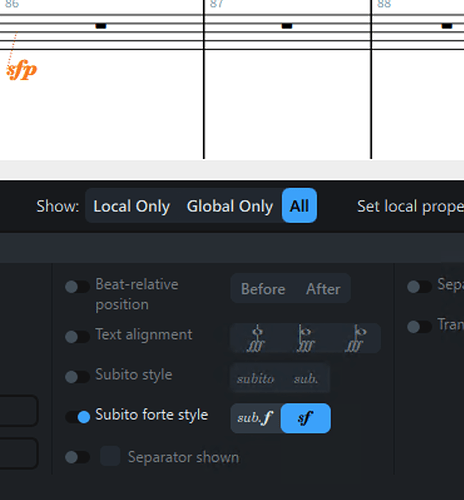To answer your first question, sf = sfz in Dorico. To eliminate the suffix sub. from immediate dynamics, select them and execute the command Edit>Reset Appearance.
Thanks John that worked to deactivate subito . Good to know that sf and sfz are the same. This enables me to use the same designation as in the original score. Further reflecting sfp in the Beethoven scores might actually be subito forte piano.
At the risk of being pedantic, I point out that the s in sf does not stand for subito nor would Beethoven, who knew Italian, have understood it that way. The Italian verb sforzare is one of a group of words that begin in sf, including sfortuna (misfortune), sfinito (exhausted). The s- is a prefix (I assume descended from an earlier form des-) that acts as an intensifier, so that forzare (to force) becomes sforzare which means ‘to force’ but also ‘to strain.’
The sfp that Beethoven uses is an abbreviation of sforzato-piano.
Beethoven, the composer most associated with subito dynamics, used sf and nothing but sf (no fz or sfz) as a strong accent throughout the first editions and manuscripts of all of his 32 piano sonatas. He never used sf to mean subito forte nor, to my knowledge, did the major composers who followed him.
And I agree with Mark Johnson above about pf. It is such a rare marking that it doesn’t even deserve to be in a list of standard dynamics, much less in first place.
I’ve never found this type of interpretation, but I would say that this wouldn’t be coherent with the way adverbs (molto, subito, poco) are associated with dynamics.
Parts of glyphs, like in the case of “sf” or “sfz”, are abbreviations of the full word. If a variation in speed or intensity is required, an adverb is added as italic text, either as a full word or an abbreviation.
Therefore, “subito forte” would be “subito f”, or much more common “f subito” or “f sub.”.
Paolo
Interestingly, “pf” is associated to a totally different thing in Italian, being the abbreviation for “pianoforte” (the instrument) in the instrument’s label after the first page.
Paolo
The English-language Wikipedia page confidently conflates sf and sub. f, whereas in every other language (with a sufficiently detailed article) the correct distinction is made. Now of course it’s difficult to point to a single source of this confusion—it’s likely been perpetuated by many books and teachers over the years—but it does seem like quite an Anglophone mistake to make, doesn’t it?
Someone needs to correct that page. The very first example even has an example of a sf without comment.
I do believe this is likely because the s in sforzando is a contraction from subito-forzando, sudden force. It will generate the same type of sound, although it is indeed confusing because sfz implies a temporary single-use dynamic, whereas sub. f makes it clear that it’s a sudden but from thereon a constant dynamic. As a native English speaker that is how I would perceive it on the page, and I’m pretty sure that intepretation is consistent with other English speakers I know (I’m in the US). The Wikipedia page could use a fix there, though I definitely don’t go to Wikipedia as a primary source for anything.
The s in sforzando is not an abbreviation of súbito. Rather it is an Italian prefix that appears in such words as sbagliare, sfondare, scongelare, sfruttare, and, of course, sforzare.
Noted. The usual translation of sforzando to english is “with sudden force” so I think that’s most likely why sudden gets conflated and confused as being a contraction of subito in this context.
I agree. Indeed the “s” before some Italian words acts often as an intensifier of the meaning of the following word: sdolcinato, sminuzzare or in this case the verb sforzare :
So the" s" in sF or sFz has nothing to do with subito. (but I can be wrong of course)
I see that the (not quite accurate) translation can lead to this confusion, also because normally a sF or sfz happens suddenly and unsuspected (and this gives its particular character and usage), but calling the “s” as “subito”, sounds to my hears like saying “subito accent”, or “subito Marcato”, what doesn’t make much sense to me. (just my opinion)
Tchaikovsky also uses sfp in his markings. Has anyone on this forum figured out how to make this dynamic mark in Dorico?
What happens when you input sfp in the dynamics popover?
@MarcLarcher
Thanks so much, that did the trick. I do wish it wasn’t known as a subito F though…

